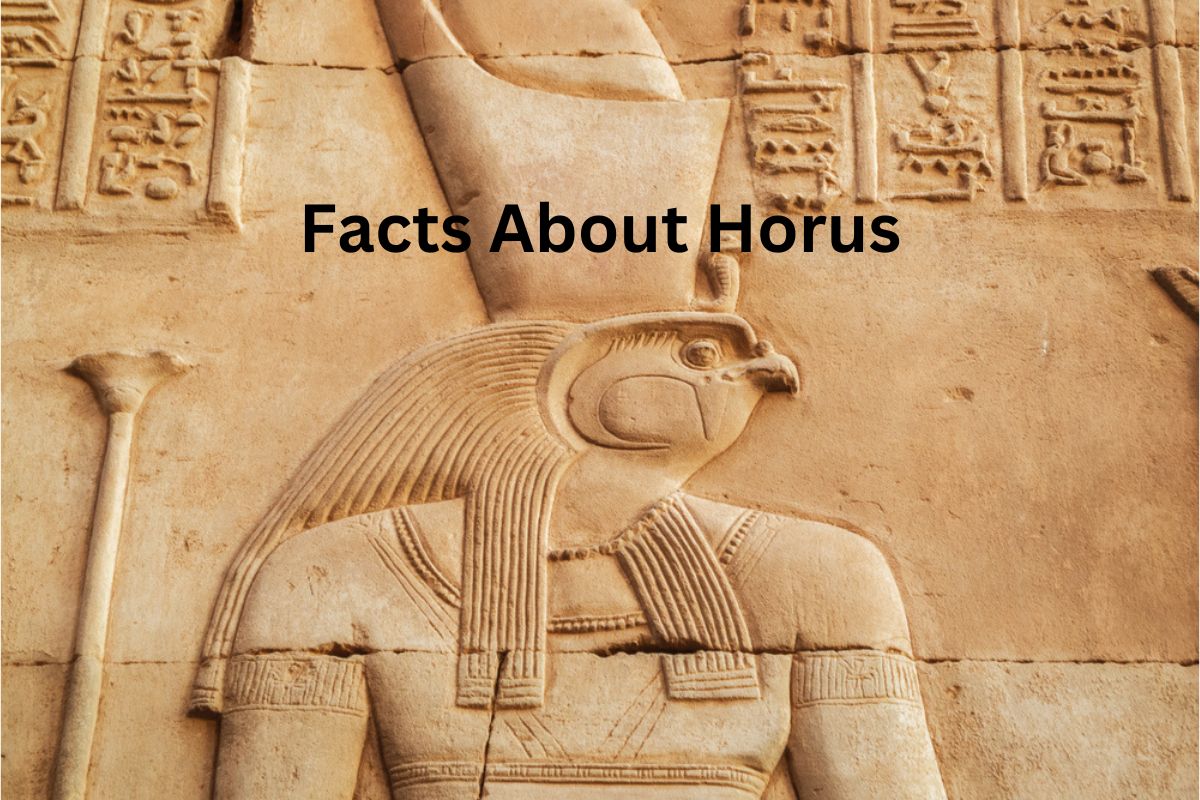Horus is an ancient Egyptian god known for his association with the sky, kingship, and protection. Often depicted as a falcon or a man with the head of a falcon, Horus represents the all-seeing, protective qualities of a divine ruler.
As the son of the goddess Isis and the god Osiris, Horus played a central role in Egyptian mythology, particularly in the story of his father’s murder by his brother Set. Horus sought to avenge Osiris and reestablish justice by battling Set for the throne of Egypt.
Closely connected to the pharaohs, who were believed to be his earthly embodiment, Horus held a significant position in ancient Egyptian religion and culture.
His influence extended beyond Egypt, shaping the religious beliefs of other cultures throughout the Mediterranean region.
With numerous temples dedicated to his worship, including the well-preserved Temple of Horus at Edfu, Horus remains one of the most iconic and widely recognized gods in Egyptian mythology.
Horus Facts
1. Horus controlled the movements of the sun and the moon
Horus is an ancient Egyptian god who holds a prominent position in the pantheon of Egyptian deities.
As a sky god, Horus was responsible for controlling the movements of the sun and the moon, making him a vital force in the natural world.
Additionally, his association with kingship and protection made him an essential figure in the daily lives of ancient Egyptians, who would invoke his name for strength and guidance.
2. Horus is depicted as a man with the head of a falcon
Horus is typically depicted as a falcon or a man with the head of a falcon. This representation is symbolic of his role as a sky god and protector.
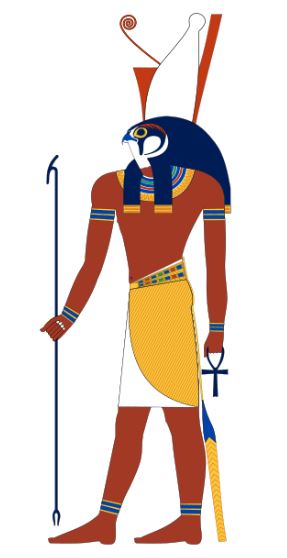
Falcons are known for their keen eyesight and their ability to soar high above the earth, which ancient Egyptians believed allowed Horus to survey and protect his domain from a vantage point unreachable by others.
The falcon also symbolized divine kingship, making Horus the ideal embodiment of both physical and spiritual power.
3. The Eye of Horus
The Eye of Horus, also called the Wadjet, is an ancient Egyptian symbol representing protection, royal power, and good health. It is often depicted as a stylized eye with a distinctive teardrop marking below it.
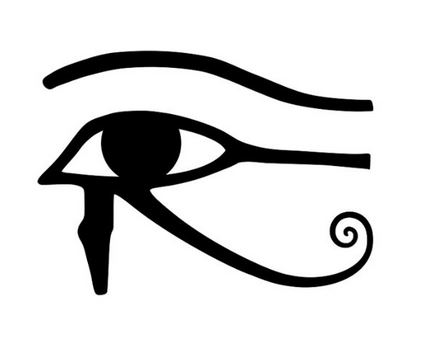
The Eye of Horus was believed to possess magical powers that could ward off evil and bring blessings to those who wore or displayed it.
Amulets and talismans featuring the Eye of Horus were commonly used by ancient Egyptians to invoke divine protection for themselves and their loved ones.
4. Horus is considered the son of the goddess Isis
Horus is considered the son of the goddess Isis, associated with motherhood and magic, and the god Osiris, associated with the afterlife and resurrection.
His birth story is an essential aspect of Egyptian mythology, as it represents the triumph of good over evil and the restoration of order after chaos.
Also Read: Facts About Osiris
According to the myth, after Osiris was murdered by his brother Set, Isis used her magical powers to conceive Horus by resurrecting her dead husband temporarily.
Horus was then raised in secret, away from the eyes of Set, until he was ready to challenge his uncle for the throne of Egypt.
5. Horus avenged Osiris
In Egyptian mythology, Horus plays a crucial role in avenging the murder of his father, Osiris, by his uncle Set.
Set, the god of chaos and storms, killed Osiris and usurped his throne, plunging Egypt into a period of darkness and turmoil.
As Horus matured, he sought to reclaim his father’s throne and restore order by battling Set in a series of epic conflicts. These battles, which involved both physical and magical confrontations, ultimately led to Horus’ victory and the reestablishment of harmony in Egypt.
This story of Horus avenging Osiris symbolizes the triumph of good over evil and the cyclical nature of life and death.
6. Horus was a sky god
As a sky god, Horus held dominion over the celestial bodies and was often associated with the sun and the moon.
His right eye was believed to represent the sun, while his left eye symbolized the moon. The merging of these celestial bodies within Horus exemplified his role as a unifying force in Egyptian mythology.
Ancient Egyptians believed that the daily cycle of the sun and moon mirrored the eternal struggle between Horus and Set, with Horus emerging victorious each day to bring light to the world.
7. Horus was intimately connected with the pharaohs
Horus was intimately connected with the pharaohs of Egypt, who were considered his earthly embodiments.
Ancient Egyptians believed that upon their coronation, pharaohs became the living incarnation of Horus, ruling over the land in his name.
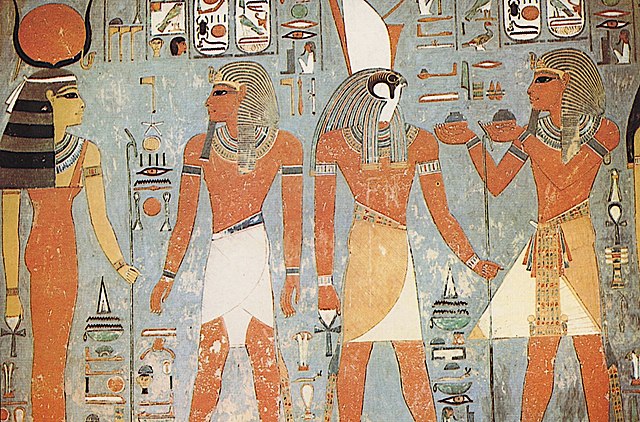
This divine connection granted the pharaohs both religious and political authority, legitimizing their rule and reinforcing the divine order of the cosmos.
The concept of the “Divine King” was central to ancient Egyptian culture and served to maintain social and religious stability throughout their history.
8. Horus had four sons
Horus had four sons, known as the Four Sons of Horus, who played crucial roles in the protection of the deceased during the mummification process.
Imsety, Hapi, Duamutef, and Qebehsenuef were each associated with a specific cardinal direction and the protection of a particular internal organ.
- Imsety, represented as a human, guarded the liver
- Hapi, depicted as a baboon, protected the lungs
- Duamutef, portrayed as a jackal, safeguarded the stomach
- Qebehsenuef, shown as a falcon, looked after the intestines.
These deities were often depicted on canopic jars used to store the preserved organs of the deceased, ensuring their protection in the afterlife.
9. Horus had several different forms
Horus had several different forms and aspects in Egyptian mythology, reflecting the diverse and complex nature of the Egyptian pantheon.
Haroeris, or Horus the Elder, represented the cosmic aspect of Horus and was considered a more ancient and powerful manifestation of the god.
Harsiesis, or Horus the Younger, was more closely tied to the myth of Osiris and Isis and symbolized the struggle for kingship and the restoration of order.
These various forms of Horus allowed the ancient Egyptians to explore different aspects of his character and his influence on their lives.
10. There are many temples dedicated to Horus
Numerous temples dedicated to Horus can be found throughout Egypt, highlighting the widespread reverence for this deity.
The most famous of these temples is the Temple of Horus at Edfu, which is one of the best-preserved ancient Egyptian temples.
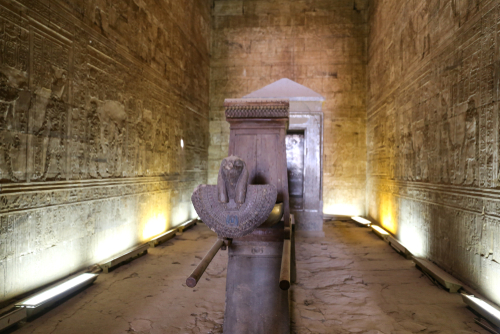
Construction of the temple began in 237 BCE during the reign of Ptolemy III and was completed nearly 180 years later in 57 BCE under Ptolemy XII.
The Temple of Horus at Edfu is an architectural marvel, featuring intricate carvings and reliefs that illustrate the myths and stories surrounding Horus and his divine family.
11. The Contendings of Horus and Set
The struggle between Horus and Set for the throne of Egypt is recounted in a well-known mythological text called “The Contendings of Horus and Set.”
This narrative provides a detailed account of the various trials, contests, and confrontations between the two gods, spanning over 80 years.
The story emphasizes the balance between order (represented by Horus) and chaos (represented by Set) and the importance of maintaining harmony in the universe.
Ultimately, Horus emerges victorious and is declared the rightful ruler of Egypt, restoring order and justice to the land.
12. Horus in Astrology
In ancient Egyptian astrology, Horus was connected to the zodiac constellation Scorpio. This association links the mythological battle between Horus and Set to the celestial realm, as Scorpio is believed to represent the struggle between good and evil or light and darkness.
The connection to Scorpio underscores Horus’ role as a protector and avenger, as the constellation is associated with power, transformation, and the ability to overcome obstacles.
13. Influence on other cultures
The worship of Horus extended beyond the borders of Egypt, influencing the religious beliefs of other cultures in the Mediterranean region.
The concept of the “divine king” linked to Horus may have played a role in the development of the Greco-Roman deity Apollo, who also held associations with the sun, healing, and protection.
Similarly, the idea of the “Divine Son” in Christianity, embodied by Jesus Christ, can be seen as bearing resemblance to the story of Horus, with both figures serving as agents of divine intervention and restoration of order.
The parallels between these figures highlight the lasting impact of Horus on religious and cultural traditions throughout history.
